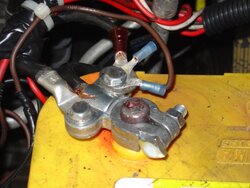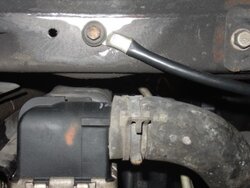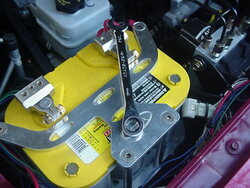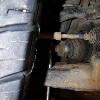aldive
Elite In Memoriam
- Joined
- January 17, 2001
- Messages
- 24,667
- Reaction score
- 28
- Year, Model & Trim Level
- 1999 XLT
Since I was having potential charging issues at idle speed after the install of my underdrive pulley ( http://www.explorerforum.com/forums/showthread.php?t=152040&highlight=underdrive ), I decided to do a “Big 3” ( alternator B + terminal to positive battery terminal, negative battery terminal to frame, frame to motor ) wiring upgrade prior to more drastic measures such as either a new 200 amp alternator or swapping to an overdrive alternator pulley ( http://underdog-performance.com/index.html ).
This installation was on my 4.0 SOHC but would be comparable on the other motors.
My plan was to add supplementary 4 gauge wiring to my 130 amp alternator to help the electrons freely flow.
I added a new red 4 gauge wire from the B+ terminal of the alternator to the battery ( Optima Yellow Top ) and also added 4 gauge black grounds from the negative terminal of the battery to the frame as well as a 4 gauge black wire from the frame to the alternator bracket bolt.
The wire was purchased from West Marine ( http://westmarine.com/ ) for $3.69 per foot and the terminals at $4.85 for a pack of 2.
I measured the wire runs and cut the wire to the appropriate lengths and crimped on the terminals.
The wire from the B+ alternator terminal to the positive battery terminal was routed from the alternator under the upper intake and over to the positive battery terminal.
The new ground from the negative battery terminal to the frame was routed down below the battery to the driver’s side frame. After thoroughly sanding the area the terminal was bolted in place.
The new ground wire ( from the passenger side frame to the two upper alternator mounting bolt ) was routed down to the frame. After thoroughly sanding the area the terminal was bolted in place.
Idle voltage reading at the battery before the new wiring was 12.8 volts and after the install it was 12.8 volts; no improvement.
Even though this mod did not solve my low voltage at idle problem, it is a worthy mod for any application and essential with high output alternators. The installation took about 1 hour to complete and cost about $55.00.
It looks like an overdrive alternator pulley is next on my list.
This installation was on my 4.0 SOHC but would be comparable on the other motors.
My plan was to add supplementary 4 gauge wiring to my 130 amp alternator to help the electrons freely flow.
I added a new red 4 gauge wire from the B+ terminal of the alternator to the battery ( Optima Yellow Top ) and also added 4 gauge black grounds from the negative terminal of the battery to the frame as well as a 4 gauge black wire from the frame to the alternator bracket bolt.
The wire was purchased from West Marine ( http://westmarine.com/ ) for $3.69 per foot and the terminals at $4.85 for a pack of 2.
I measured the wire runs and cut the wire to the appropriate lengths and crimped on the terminals.
The wire from the B+ alternator terminal to the positive battery terminal was routed from the alternator under the upper intake and over to the positive battery terminal.
The new ground from the negative battery terminal to the frame was routed down below the battery to the driver’s side frame. After thoroughly sanding the area the terminal was bolted in place.
The new ground wire ( from the passenger side frame to the two upper alternator mounting bolt ) was routed down to the frame. After thoroughly sanding the area the terminal was bolted in place.
Idle voltage reading at the battery before the new wiring was 12.8 volts and after the install it was 12.8 volts; no improvement.
Even though this mod did not solve my low voltage at idle problem, it is a worthy mod for any application and essential with high output alternators. The installation took about 1 hour to complete and cost about $55.00.
It looks like an overdrive alternator pulley is next on my list.















